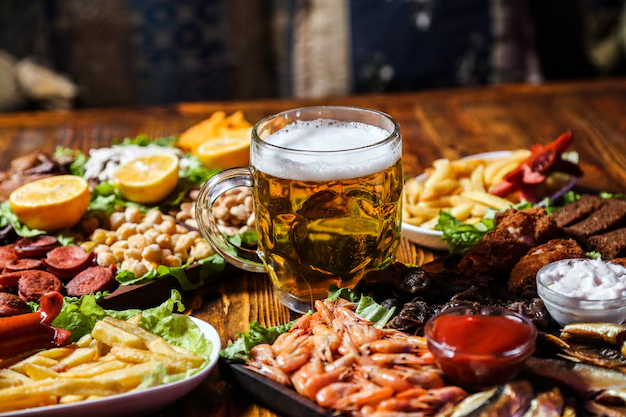Food and drink have always been at the heart of every culture, offering a glimpse into the history, traditions, and values of people across the globe. Whether it’s savoring a street-side taco in Mexico or indulging in a perfectly aged glass of wine in France, the world of food and drink is an adventure that tantalizes the senses and connects people from all walks of life. This journey not only celebrates the delicious dishes we enjoy, but also the stories behind them—stories that speak of creativity, passion, and craftsmanship.
The Evolution of Culinary Traditions
Food has always been much more than sustenance. It is an expression of art, a reflection of geography, and a symbol of a community’s heritage. From the ancient civilizations of Egypt and Mesopotamia to today’s global food networks, culinary practices have evolved based on geography, trade, and innovation.
In ancient times, food production was local and often dictated by the environment—what grew naturally or was easily domesticated. With the advent of trade routes, spices, and exotic ingredients began making their way from one region to another, forever transforming the flavor profiles of food. For example, the Silk Road introduced flavors like cumin and cinnamon to the West, while Europe’s exchange with the Americas brought ingredients like tomatoes, potatoes, and chili peppers to the Old World.
This cross-cultural exchange continued through colonialism, migration, and globalization, resulting in the fusion of flavors we now enjoy in international cuisine. The modern food and drink landscape is a fusion of both ancient traditions and contemporary influences, resulting in an exciting and ever-evolving culinary scene.
Exploring the Diverse World of Food & Drink
One of the most exciting aspects of food and drink is its diversity. Every region offers its own unique set of flavors, cooking methods, and beverages, providing endless opportunities for discovery.
- European Delights: European cuisine ranges from the rich, buttery dishes of France to the hearty, simple meals of Italy. French cuisine is known for its meticulous preparation and delicate flavors, often paired with wines that complement the meal perfectly. On the other hand, Italian food celebrates fresh ingredients and bold flavors, with pasta and olive oil at the heart of its culinary identity. Germany, Spain, and the UK also have their own distinct food cultures, including beer-centric meals, tapas, and traditional British pies.
- Asian Cuisine: Asia offers some of the most complex and layered food experiences. From the delicate sushi of Japan to the spicy curries of Thailand and India, the continent is a treasure trove of culinary traditions. Chinese cuisine varies by region, from the hot and sour flavors of Sichuan to the subtle, balanced tastes of Cantonese dishes. Street food, such as dim sum or pho, has also gained worldwide recognition for its delicious and accessible nature.
- Latin American Flavors: The foods of Latin America are a vibrant mix of indigenous ingredients and European influence. Mexican food, for instance, is known for its use of corn, beans, and chilies, while Brazilian cuisine often features grilled meats and tropical fruits. Argentina, with its famous asado (barbecue), offers a glimpse into the social aspect of food, where cooking is often a communal event.
- African Influence: African cuisine is equally diverse, with each region offering distinct dishes that reflect the local culture and natural resources. In North Africa, spices like saffron and cumin elevate dishes such as couscous and tagine. In sub-Saharan Africa, ingredients like yams, plantains, and cassava are staples in a variety of savory stews and grilled meats.
- Drink Around the World: Beyond food, beverages are integral to culinary traditions. Coffee, tea, wine, beer, and spirits have been intertwined with food for centuries, each region developing its own iconic drinks. Think of the strong espresso in Italy, the tea ceremonies in Japan, or the margarita in Mexico. Wine-producing countries like France, Spain, and Italy also boast a strong wine culture, where each region’s unique terroir shapes the flavor of its wines.
The Art of Pairing Food & Drink
One of the most exciting areas of culinary exploration is the art of food and drink pairing. For centuries, cultures have developed intricate pairings that enhance the flavors of both the food and the drink. The perfect wine pairing can elevate a meal, while a well-crafted cocktail can provide a refreshing contrast to spicy dishes. Pairing is about balancing flavors—rich and light, sweet and savory, hot and cold—creating a harmonious dining experience.
For example, red wine pairs beautifully with dishes like steak or lamb, while white wine complements seafood and chicken. Beer and food pairings are also a growing trend, with craft breweries offering beer styles that go well with everything from spicy Asian food to rich barbecued meats.
7 FAQs About Food & Drink
- What are some popular food and drink pairings? Common pairings include red wine with steak, white wine with fish, and beer with burgers. Cheese and wine, as well as chocolate and coffee, also make great combinations.
- Why do different regions have distinct cuisines? Local ingredients, climate, cultural practices, and trade routes shape the culinary traditions of a region. Over time, these factors create unique and diverse flavors and dishes.
- What is the significance of food in different cultures? Food is deeply tied to culture, tradition, and identity. It brings people together and is used to celebrate milestones, holidays, and rituals.
- How has globalization impacted food trends? Globalization has led to the blending of culinary traditions from around the world, resulting in fusion cuisines and an increasing availability of international ingredients.
- What are some examples of fusion cuisine? Examples include sushi burritos, Korean tacos, and Indian-style pizzas, all of which combine elements from different culinary traditions.
- What are some must-try foods when traveling? Some iconic dishes include Italy’s pasta, Mexico’s tacos, Japan’s sushi, India’s curry, and Thailand’s pad thai.
- How does drink culture differ around the world? Drink culture varies by region. In Italy, espresso is a daily ritual, in Japan, tea ceremonies are a cultural tradition, and in France, wine is a central part of meals.
Conclusion
Exploring the world of food and drink is not only a journey of taste but one that connects us to history, culture, and human creativity. It is a celebration of diverse flavors, traditions, and the joy that comes from sharing a meal or a drink with others. Whether you’re enjoying a home-cooked meal or sampling the culinary wonders of a distant land, food and drink have the power to bring people together, offering an endless array of experiences to explore.
Key Takeaway
The culinary world is vast and filled with endless opportunities for discovery. By understanding the cultural significance, history, and art of food and drink, we can deepen our appreciation for what’s on our plates and in our glasses. Exploring this world isn’t just about the food—it’s about embracing the stories, the people, and the traditions behind every dish and drink, making each experience unique and unforgettable.




